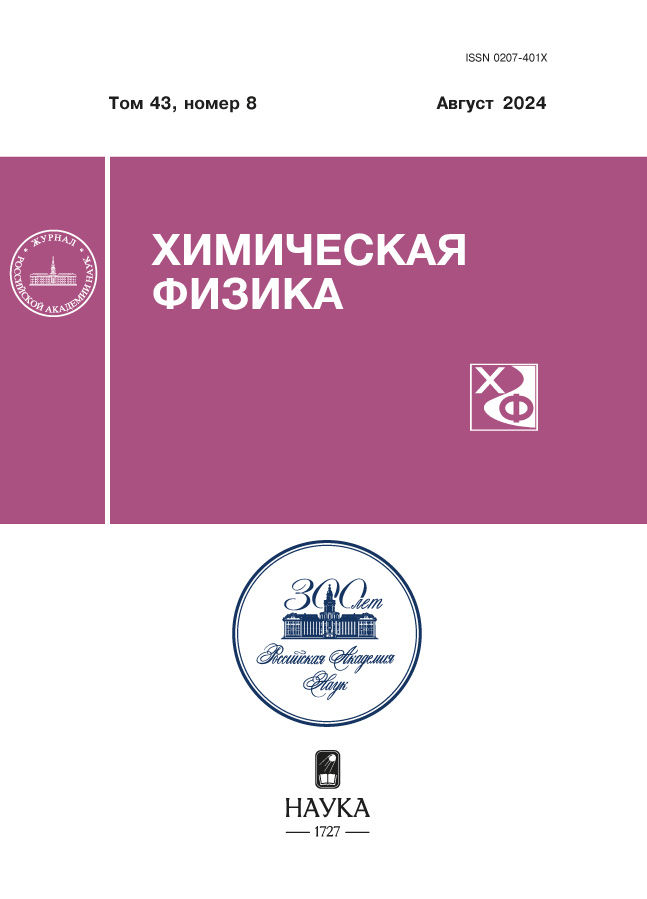Acceleration ability of the mixtures of explosives with positive and negative oxygen balance
- Authors: Makhov M.N.1
-
Affiliations:
- Semenov Federal Research Center for Chemical Physics, Russian Academy of Sciences
- Issue: Vol 43, No 8 (2024)
- Pages: 62-69
- Section: Combustion, explosion and shock waves
- URL: https://cijournal.ru/0207-401X/article/view/681885
- DOI: https://doi.org/10.31857/S0207401X24080076
- ID: 681885
Cite item
Abstract
The possibilities of increasing the acceleration ability (AA) of energetic materials due to creation of compositions combining high explosives (HE) with positive and negative oxygen balance are analyzed. For calculations, three relatively new compounds were selected as HE-oxidizers: 3,6-dinitro-1,4-bis(trinitromethyl)-1,4-dihydropyrazolo[4,3-c]pyrazole; 4,4′5,5′-tetranitro-2,2′-bis(trinitromethyl)-2Н,2′Н-3,3′-bipyrazole; 2-dinitromethyl-5-nitrotetrazole. HMX and CL-20 performed the function of HE-fuel. From the calculations it follows that the AA of HMX increases markedly with the addition of mentioned oxidizers, and the introduction of oxidizers into the composition with CL-20 leads to a slight increase in AA.
Full Text
About the authors
M. N. Makhov
Semenov Federal Research Center for Chemical Physics, Russian Academy of Sciences
Author for correspondence.
Email: mmn13makhov@yandex.ru
Russian Federation, Moscow
References
- S.G. Andreev, A.V. Babkin, F.A. Baum, et al., Physics of Explosion, Ed. by L.P. Orlenko (Fizmatlit, Moscow, 2002), Vol. 1 [in Russian].
- Methods for studying the properties of materials under intense dynamic loads. Ed. by M.V. Zhernokletov (RFNC-VNIIF, Sarov, 2003) [in Russian].
- D.R Hardesty and J. E. Kennedy, Combust. Flame 28, 45 (1977).
- H. Hornberg, Propell. Explos. Pyrotech. 11, 23 (1986).
- M. Finger., E. Lee., F.H. Helm, et al., in Proceedings of the 6th International Symposium on Detonation, ONR ACR-221 (Office of Naval Res., Arlington, 1976), p. 710.
- R.W. Gurney, Report BRL 405, Army Ballistic Research Laboratories (Aberdeen Proving Ground, MD, USA, 1943).
- M.J. Kamlet and M. Finger, Combust. Flame 34, 213 (1979).
- A. Koch, N. Arnold, and M. Estermann, Propell., Explos., Pyrotech. 27 (6), 365 (2002). https://doi.org/10.1002/prep.200290007
- J.-F. Danel and L. Kazandjian, Propell., Explos., Pyrotech. 29 (5), 314 (2004). https://doi.org/10.1002/prep.200400060
- M.N. Makhov, in Combustion and Explosion, Ed. S.M. Frolov (Torus Press, Moscow, 2008), No. 1, p. 93 [in Russian].
- M.N. Makhov, Gorenie Vzryv 8 (2), 256 (2015).
- V.Yu. Davydov and A. S. Gubin, Russ. J. Phys. Chem. B 5 (3), 491 (2011). https://doi.org/10.1134/S1990793111030183
- M.F. Gogulya, M.N. Makhov, M.A. Brazhnikov, et al., Combust., Explos., Shock Waves 44, 198 (2008).
- M.N. Makhov, Russ. J. Phys. Chem. B 12 (2), 258 (2018). https://doi.org/10.1134/S1990793118020203
- M.N. Makhov and V.I. Arkhipov, Russ. J. Phys. Chem. B 2 (4), 602 (2008).
- M.N. Makhov, Gorenie Vzryv 16 (2), 110 (2023). https://doi.org/10.30826/CE23160209
- M.N. Makhov and V.I. Arkhipov, Fiz. Goreniya Vzryva 25 (3), 87 (1989).
- M.N. Makhov, M.F. Gogulya, A.Yu. Dolgoborodov, et al., Fiz. Goreniya Vzryva 40 (4), 96 (2004).
- L.N. Akimova, G.T. Afanas¢ev, V.G. Shchetinin, and V.I. Pepekin, Khim. Fizika. 21 (3), 93 (2002).
- A.V. Dubovik, Russ. J. Phys. Chem. B 15 (4), 696 (2021). https://doi.org/10.1134/S1990793121040151
- A.V. Dubovik, Russ. J. Phys. Chem. B 16 (2), 260 (2022). https://doi.org/10.1134/S1990793122020051
- A.V. Dubovik, Russ. J. Phys. Chem. B 17(2), 369 (2023). https://doi.org/10.1134/S1990793123020057
- G.M. Nazin, B.L. Korsunskiy, A.I. Kazakov, A.V. Nabatova, and N.G. Samoylenko, Russ. J. Phys. Chem. B 17 (2), 406 (2023). https://doi.org/10.1134/S1990793123020124
- V.I. Arkhipov, M.N. Makhov, and V.I. Pepekin, Khim. Fizika. 12 (12), 1640 (1993).
- Energy condensed systems, 3rd ed. Ed. by B.P. Zhukov (Yanus-K, Moscow, 2000) [in Russian].
- R.L. Sympson, P.A. Urtiew, D.L. Ornellas, et al., Propell., Explos., Pyrotech. 22 (5), 249 (1997).
- Ya.O. Inozemtsev, A.V. Inozemtsev, M.N. Makhov, A.B. Vorob¢ev, and Yu.N. Matyushin, Russ. J. Phys. Chem. B 54 (6), 1005 (2021). https://doi.org/10.1134/S1990793121060178
- K. Mohammad, V. Thaltiri, N. Kommu, and A.A. Vargeese, Chem. Commun. 56, 12945 (2020). https://doi.org/10.1039/D0CC05704E
- I.N. Zyuzin, I.Yu. Gudkova, and D.A. Lempert, Russ. J. Phys. Chem. B 16 (5), 902 (2022). https://doi.org/10.1134/S1990793122060240
- I.L. Dalinger, K.Yu. Suponitsky, T.K. Shkineva, D.B. Lempert, and A.B. Sheremetev, J. Mater. Chem. A 6 (30), 14780 (2018). https://doi.org/10.1039/C8TA05179H
- X.X. Zhao, S.H. Li, Y. Wang, et al., J. Mater. Chem. A 4 (15), 5495 (2016). https://doi.org/10.1039/C6TA01501H
- I.N. Zyuzin, I.Yu. Gudkova, and D.A. Lempert, Russ. J. Phys. Chem. B 14 (5), 804 (2020). https://doi.org/10.1134/S1990793120050140
Supplementary files

















